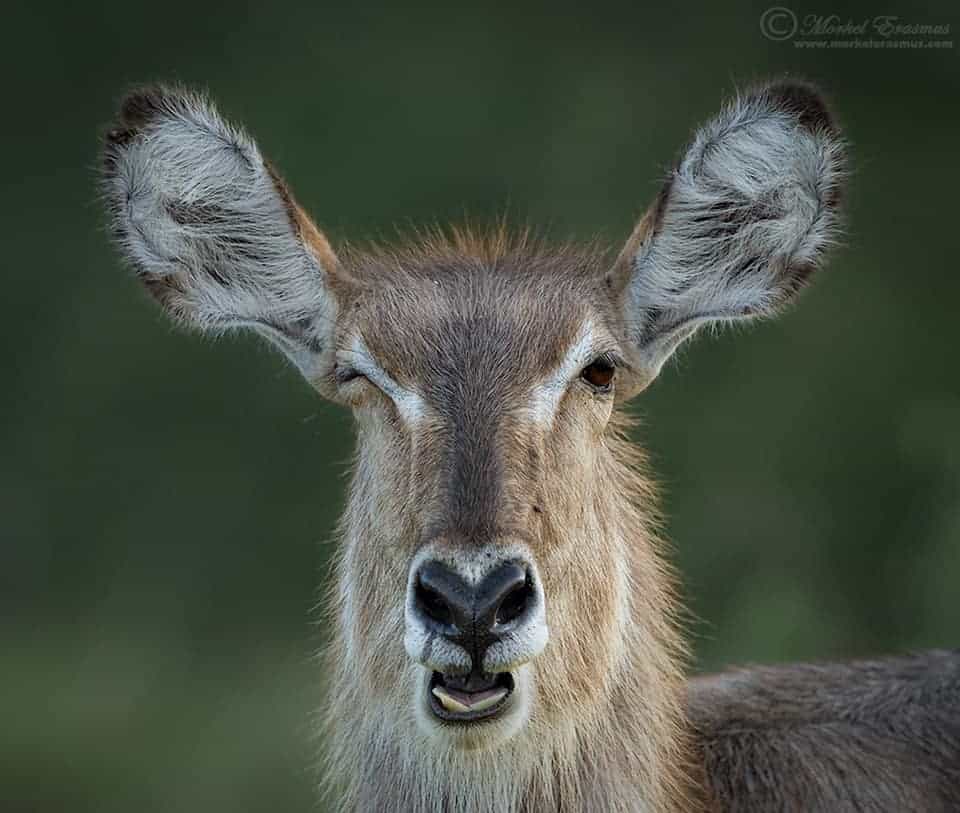I was trawling through my archives tonight, making space for new files by deleting files that are now 2+ years old that I haven’t touched yet, when I came across this photo.
The species depicted is a Common Waterbuck, found throughout much of Southern Africa. The photo was taken in the Kruger National Park late one afternoon in March 2012 – a few minutes after sunset.
There are two things I want to point out here. The first is obviously the pose – I had a couple that just showed this female’s facial portrait outline. They were deleted.
This one, a crucial moment in this sighting, is something quirky and I kept it. She was merely trying to ward a fly off by batting her one eyelid, but the photo takes on a whole new implied meaning with this expression, don’t you think?

The other thing of note – is the ISO setting. The light was pretty much gone, and to get sufficient depth-of-field I needed to stop down the aperture. For some reason I had a high shutter speed too, so this necessitated the ISO setting.
Techs:
Nikon D3s
Nikkor 500mm f4 VR-II
1.4x teleconverter
f8.0 | 1/1250 SS | ISO-9000
I love being able to make images at these ISO settings, images that are actually usable! Just recently a photo of mine was accepted by Gallo Images, a high profile stock library in South Africa that’s affiliated with Getty Images in the USA, which was taken at ISO-7200! The low light capability of the Nikon FX sensor enables me to really push the limits when it comes to photographing in the dusk hours of the day.
Some of you may be thinking that it looks better because it’s a downsized and processed photo. There’s some truth to that, as downsizing reduces apparent noise and I did run some selective noise reduction on the background – but the clincher for me is not whether there is noise/grain, but what amount of fine detail, contrast and dynamic range is captured at these settings and in these conditions. Here is a 100% crop of the eye, meaning it was cropped down to this resolution of just below 800px wide, no downsizing done and zero other processing done except for my RAW exposure adjustments in Lightroom.

Yes, there is noise present, but there’s also oodles of detail for me to work with.
Folks – trust your cameras! Trust the technology that went into making the sensor and the electronics that convert the light captured into a usable image. Push yourself to make images at times that you previously put the camera down because of “lack of light”.
Until next time!
Morkel Erasmus
Morkel Erasmus
I used to relish writing these kinds of “bio” pieces and would flaunt the odd impressive word and use dashing grammar to make it sound like I am a boundary-shifting photographer. These days I prefer stating it in much simpler ways, much more relatable ways, much more believable ways… The fact of the matter is this: I love Africa. I love its people, its wild places and its wildlife. I love being immersed in these places, observing and photographing the fall of light on the land and the daily lives of the creatures that call it home, and presenting the results to whoever will take a look. To me, nature photography is all about being in the moment, and capturing that moment in a way that can relate to someone who didn’t have the privilege of being there with me. Sometimes I am able to capture a unique vision of the scene before me, and sometimes I just capture it the way most folks would according to classical photographic guidelines. Yet I always enjoy sharing the images and experiences and imparting the knowledge I have, both in-the-field and later online or in presentations, workshops and courses. I also just simply enjoy capturing and sharing the beauty of God's creation! The greatest thing I’ve found about wildlife and nature photography in Southern Africa is the unity and familiarity of the community of people that share this passion. We come from all walks of life and all cultures and backgrounds, yet our passion for our natural heritage and our dream to see it preserved for future generations binds strangers together and fuels conversations around campfires long after other people have run out of conversation and energy. Join me on a WildEye adventure to experience this sharing community spirit and learn to anticipate that fleeting moment and be ready for it, learn to immerse yourself in the experience without losing focus of your photographic goals…and above all, learn to see Africa anew… because there are none as blind as those who look but do not see!
- Web |
- More Posts(111)
Leave a Reply